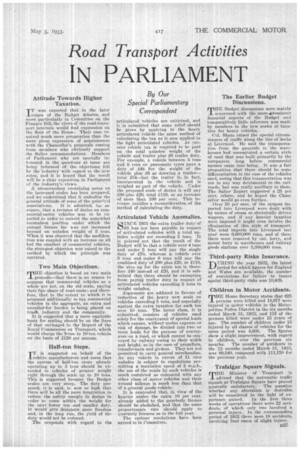By Our Special Parliamentary Correspondent
Page 109

If you've noticed an error in this article please click here to report it so we can fix it.
'articulated vehicles are criticized, and it is submitted that some relief should be given by applying to the heaVy articulated vehicle the same method of calculating the tax as is now applied to the light articulated vehicles. At present vehicle tax is' req_uired to be paid on the total unladen weight of the vehicle and trailer plus £6 trailer duty. For example, a vehicle between 5 tons and 6 tons on pneumatic tyres pays a duty of £48 for the weight of the vehicle plus £6 as drawing a trailer— total £54—but the trailer is, in fact, incorporated in the vehicle and is weighed as part of the vehicle. "Under the proposed scale of duties it will pay £90 plus £20, total £110, or an increase of more than 100 per cent. This increase justifies a reconsideration of the method of calculating the duty.
Articulated Vehicle Anomalies.
INCE 1931 the extra trailer duty of OD; has not been payable in respect of articulated vehicles with a total unladen weight not exceeding 5 tons. It is pointed put that the result of the Budget will be that a vehicle over 4 tons and under 5 tons will pay the single duty of £70, whereas a vehicle over 5 tons and under 6 tons will pay the combined duty of £90 plus £20, or £110, the step up for the extra ton is therefore £40 instead of £20, and it is submitted that there should be exemption from payink trailer duty in respect of articulated vehicles exceeding 5 tons in weight unladen. Arguments are adduced in favour of reduction of the heavy new scale on vehicles exceeding 5 tons, and especially against the extra taxation for each ton over 10 tons. The latter class, it is submitted, consists of vehicles used solely for the conveyance of special loads which cannot, without undue expense or risk of damage, be divided into two or more loads for the purpose of conveyance on a road, or which cannot be conveyed by railway owing to their width and height, as in the case of propellers, transformers and girders. They are not permitted to carry general merchandise. As any vehicle in excess of 11 tons unladen is subject to regulations permitting a maximum speed of 5 m.p.h., the use of the roads by such vehicles is much restricted as compared with any other class of motor vehicles and their annual mileage is much less than that of a general goods vehicle. It is contended that, in view of the heavier scales the extra 10 per cent. already added to the quarterly licence should be abolished, and that the same proportionate rate should apply to quarterly licences as to the full year. The various resolutions have been agreed to in Committee.




























































































































































































